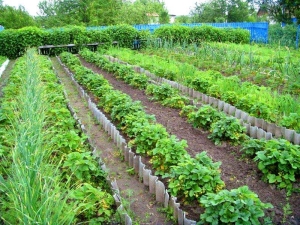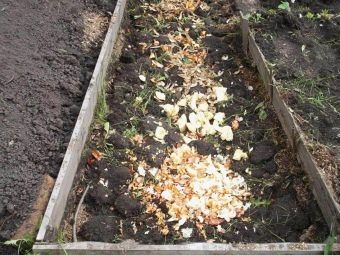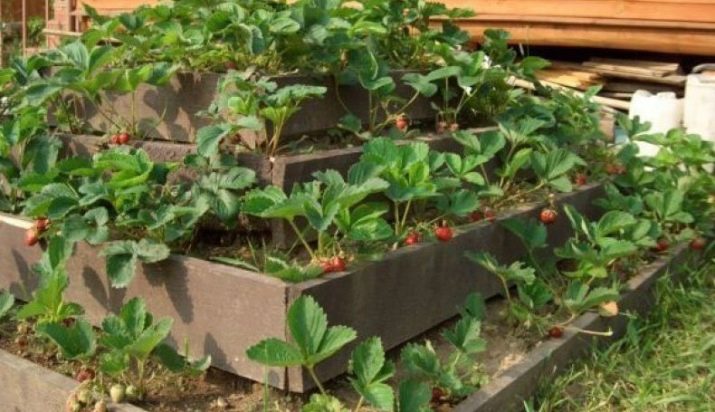Types of beds for strawberries

Strawberry is a southern berry, and in order to get an excellent harvest, it is necessary to provide it with complete care and conditions as close as possible to the warm sunny climate.
The expediency of the formation of beds
Strawberry bush, contrary to popular belief, quite unpretentious plant. At the right place, the bushes bear fruit well for 3-5 years. After that, the root system of the uterine bushes becomes obsolete, the soil is depleted, and a noticeable decrease in yield indicators occurs. But besides these well-known components, there is another aspect of growing - the formation of beds. This important moment, which novice gardeners lose sight of, includes several parameters at once.
- Natural consists of the following indicators:
- lighting - strawberry bushes should receive the maximum amount of sunlight, and, therefore, the beds should be located on the cardinal points;
- precipitation - it is necessary to take into account the seasonality of rain in your region, the frequency and force of the winds;
- location - when choosing a field for strawberries, shaded lowlands and areas of rain and melt water should be avoided.
- Landscape. Strawberry bushes are planted for 3-5 years, so you should take care of the appearance of your strawberry plantation. Especially if the landscape design is thought out to the smallest detail and already has its well-established style.
- Availability. Each bush must be provided with a convenient approach so that when watering, feeding and trimming the whiskers one can comfortably sit next to the tools without damaging the rest of the plants. Accessibility to the beds is important when harvesting, so as not to suppress the berries on the neighboring bushes.
Location regardless of design
Before proceeding to the design of a strawberry plantation on the site, it is necessary to find out the basic rules of agricultural engineering. So, regardless of the type of beds there are rules for planting strawberries. They will create an optimal microclimate for the full growth and nutrition of plants. Immediately it is necessary to exclude from the plan a place in the shading of outbuildings, fences and fruit trees. Exception is subject to lowland area. Insufficient lighting will not allow strawberries to ripen, berries will rot on constantly wet soil, and water from rain and spring floods will destroy the root system.
You should choose high, well-lit areas, oriented from east to west, so that the sun illuminates the plantation throughout the day. Ideally, such sites are planned between natural wind barriers. Currant bushes, gooseberries will do - they will not block out the sunlight, but will save from gusts of strong wind and slanting rain.
Proper formation of beds will allow free air circulation between plants, easy access for care and harvesting.
Kinds of beds and their device
Modern gardening provides an inexhaustible number of ideas for the equipment of the berry plantation. So, the simplest strawberry ridges will have a low horizontal position. This is a standard bed, which is commonly called for the lazy. She does not require any specific skills and additional materials. The desire for creativity, the decoration of the garden area can create unique buildings for planting berry bushes, using various designs. Or, on the contrary, forced necessity — high groundwater location, lack of space on the site — can lead to alternative solutions and the embodiment of high, vertical, multi-tiered beds.
The simplicity of the structures is due to the fact that strawberry bushes have compact dimensions, a small root system. Beds for strawberries can be made independently of scrap materials, because the main element of the beds - it bumpers. They can be wooden, carved from slate, plastic panels, automobile tires.Therefore, do not rush to throw out construction debris - from it you can create amazing design elements. It is worth considering the most popular types of beds for strawberries.
Warm
This type of beds is also called “smart” and is arranged according to the principle of puff pie, where each layer is a nutritional and warming surface. Layers of slowly decaying organic matter will nourish the roots of plants from year to year, and there will be no cold from the bottom from the soil. A warm bed is ideal not only for regions with a cool climate, where there is a risk of returning frosts, but also for southern areas. The fact is that the bed layers prevent the rapid evaporation of moisture, which is extremely important in arid regions with a scorching sun. As well as heavy showers will not erode the soil and expose the roots if the embankment has sides.
The technology of creating a warm bed is quite simple. The following layers are laid out sequentially from bottom to top:
- plant drainage - dry branches, small wood blocks or bark;
- cardboard or a thick layer of old newspapers;
- sawdust, wood shavings;
- vegetable waste that has not yet been composted - they will serve for further rotting;
- directly compost;
- a layer of garden soil on which strawberries will grow.
Important! Warm beds, as a rule, are made before winter, that is, at the beginning of autumn. Therefore, it is possible to replace the layer of vegetable waste with fallen leaves or mowed grass.
High
The design of high beds came to us from Europe, where it is customary to maximize the quality of the plots, giving a neat look to the whole garden. For the northern and central regions of our country, these beds are also relevant because they are convenient to combine with warm layers. A high bed is created using a box in which the earth or "warm" layers are placed. The frame of the box is the easiest to make of wood, and inside it is laid with steel mesh around the perimeter - this will protect the landing from rodents.
It is convenient to weed such beds, especially if they are quite high and reach the level of the belt. It is not necessary to completely fill the box with earth, you can make the pallet higher. Between framed high ridges it is convenient to mow the grass with a trimmer or to lay out a path from the gravel.
Low with shelter
This is a common planting system on the surface of the earth, with the only difference being that top covering agro-weaves is used. As a rule, in modern conditions a spunbond is used - it is a non-woven material from a polymer melt. The canvas is selected impermeable black, prevents the emergence of weeds, and also serves as insulation and protection from excessive moisture or drying out of the soil. A microclimate is formed under the canvas, which is not afraid of weathering.
The technology of landing under the canvas is quite simple. Beds are formed by the ridge method, on which bushes will be planted. Along the perimeter of the plantation and between the rows you can slightly deepen the trench, then to sprinkle the canvas. The plantation is covered with a spanbond, and holes are made in the places of the holes. The easiest way to cut them on the markup, making a cut crosswise in the designated places.
Important! For ease of marking, you can first cover the plantation with a film, mark the hole points with a marker, and then apply the film on the dark material.
Mound
This is a kind of warm beds, in which a trench is dug for laying a “filling” - dry twigs, sawdust, compost. When the organic layers reach ground level, a layer of fertile soil is poured. It turns out bulk bed height of 20-30 cm, which planted strawberry bushes.
The edges of the beds can be left flat in the usual way when landing on the ridges or arrange boards, slate, remnants of plastic panels. This method is perfect for cool regions where the earth warms up for a long time. But if the ground water is close to the surface, it is better to consider the option of high beds.
Unusual options
Due to the shallow root system, strawberry bushes can grow in a limited amount of soil, which gives a wide scope for creativity when creating landscape design, and also allows you to save space on the site, without giving precious meters to strawberries.
Types of vertical flowerbeds with pros and cons
Strawberry beds do not need to be located on the surface of the earth. And the bushes themselves, like home plants, will feel great in vertical tanks. Frameworks for flowerbeds can be of various forms, from purchased multilevel pyramids to the simplest cascade flowerbeds made from scrap materials. The main advantages of vertical structures are the following:
- space saving;
- ease of care for each plant;
- stylish decoration of the site.
For the plant itself, the vertical positioning method is good because the bushes do not come into contact with the earth's surface, which means they are less susceptible to pests and fungal diseases. However, there are downsides. In vertical beds, the ground freezes over much faster, the roots are not protected from frost. This is especially true of beds with separate capacities for each plant. In hot weather, the soil in vertical beds quickly dries out, so the main task is to constantly monitor the level of humidity, to make timely feeding and fertilizer. It is worth considering some popular options that are easy to do with your own hands.
Tiered boards
The pyramidal design is made on the principle of high beds. Boxes of boards in a decreasing size are one on another. When planting a beautiful multi-tiered cascade of hanging leaves and berries is obtained.
Tiered Tires
A column of old car tires is an actively used option. On top of the tire, holes for the seedlings are cut at a distance of 15 cm. The first tire is installed in a small depression (for stability), the drainage and garden soil are filled up. The next tire is placed in such a way that the holes are staggered.
Suspended and hanging flower beds
Here, the scope for imagination is unlimited, and any available materials can be used. Hanging flower beds - this is an original design method, which will depend on the style direction of your site. For hanging flowerbeds, cloth bags, plastic bottles, pipe trimming, and ordinary flower pots can be used.
Mobile phones
Portable designs are another design option. Such beds can be moved every season, changing the appearance of the site and planning the crop rotation of other crops. The easiest way to make a mobile bed from wooden or plastic boxes, as well as old barrels. Any of these materials can be painted with paint or spray.
Tips for choosing
For novice gardeners and for those who count on a solid harvest for harvesting for the winter, experts advise to equip the main beds in the designated area. Better to be warm. If you plan to feast on berries during the season at the cottage, and at the same time admire the design, then hanging or mobile flower beds will do. Beautiful fragrant bushes will have time to treat you with plenty of their fruits, though not in large quantities.
For information on how there are types of beds for strawberries, see the following video.



































